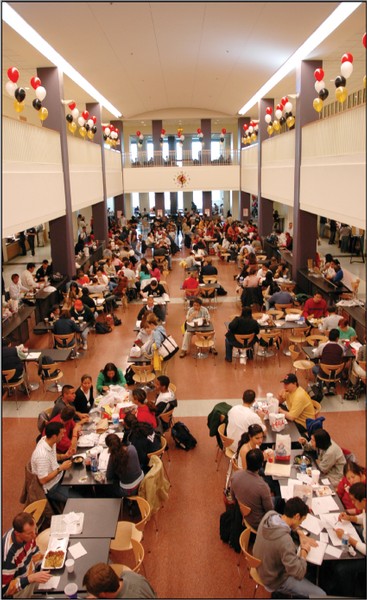Despite running $17 million over budget and finishing two years past deadline, Stamp Student Union celebrated the official completion of its renovation yesterday, coinciding with a dedication ceremony honoring the complex’s 50th anniversary.
University officials celebrated the Student Union project’s completion with a ribbon-cutting ceremony including university President Dan Mote, Student Union staff and members of the student advisory board that oversaw the construction planning process.
“When I arrived seven years ago, the project was underway — I thought I would leave before it was complete,” Mote joked as he took part in the ceremony.
Although the ceremony marked the official completion of the project, a few aspects remain under construction. The project’s final phase, which included adding student offices and a catering kitchen, was moved from January to May because of more asbestos and structural problems. The kitchen is all that is left in the project and should be complete by the end of May, Colella said.
Construction on the $57 million complex began in July 1999 with the anticipation of being completed by fall 2003.
While the plan called for the complex to be renovated in four phases, the university did not foresee the massive problems that came with the project, said Corlo Colella, the university’s director of engineering, construction and architecture.
Problems with the complex started when Stromberg Sheet Metal Works, a subcontractor hired to do heating and air-conditioning work, encountered expensive structural problems in the project’s first phase, which included the relocation of the Maryland Food Co-op and renovations to the Hoff Theater.
The problems caused the construction company to repeatedly redesign their plans, to spend the nearly half of the budget allocated for all four phases and delay completion of the first phase to January 2002.
In fall 2002, Stromberg walked off the project, claiming the university had not fully compensated the company for the $1.4 million it spent in extra costs created when design flaws had to be corrected.
Phases two and three continued to have repeated structural and asbestos problems due to the building’s old age, faulty ductwork and utility lines. The phases added a new food court, book store and coffee shop to the building.
“We really had no idea how complicated the complex was going to be,” Colella said.
The university got into more legal trouble in spring 2003 when Stromberg took legal action demanding the university reveal the project’s final costs. Even though they agreed to finish the project, when Stromberg asked for the projected final costs the university refused, prompting the company to file a lawsuit to get the information.
In spring 2003, the university threatened to take legal action against the union’s architect, Torti Gallas CHK, claiming it was responsible for two-thirds of the $17 million in cost overruns.
John King, a lawyer representing the architects, said the university never filed a lawsuit with the company, but was able to work out a deal to finish the project.
“I don’t know why they threatened legal action,” he said.
The following year, the Board of Regents gave the project an additional $2.5 million to offset the $17 million in cost overruns.
The projected final cost for the project is $57.7 million.
Despite being finished, the project has left some unfinished business with contractors responsible with the project.
Later this year, lawyers for Stromberg said the company is planning to go before the Maryland Court of Special Appeals to appeal the decision made by Prince George’s County Circuit Court requiring the university to reveal the total project costs. Stromberg will try to get reimbursed for its legal fees from the original lawsuit.
According to the Freedom of Information Act, if a company sues for information from an organization and wins, it is entitled to obtain reimbursement for these fees.
“The university violated the statute and the court proved that,” said Stromberg lawyer Roger Jones. “We feel strongly that the Prince George’s court erred in their decision.”
If done over again, Mote said he would have allotted more money for the project had he known it would have created such expensive legal fees.
“I know it may look unprofessional, but I would have added a 25 percent contingency fee to help fund the project [by covering legal costs],” he said.
Project Manager Bob Wallach, of Torti Gallas CHK, said he would only work with the university as long as it was willing to commit fully to the project.
“I don’t think anyone understood what they were getting into,” he said.
Overall, Student Union officials said the complex was something the university needed to make the campus more centralized.
“I think it’s everything that we thought it would be,” said Steve Gnadt, the Student Union’s assistant vice president. “It turned out the way that we hoped it would and more.”
Students, faculty and visitors pile into Stamp Student Union’s food court yesterday.





